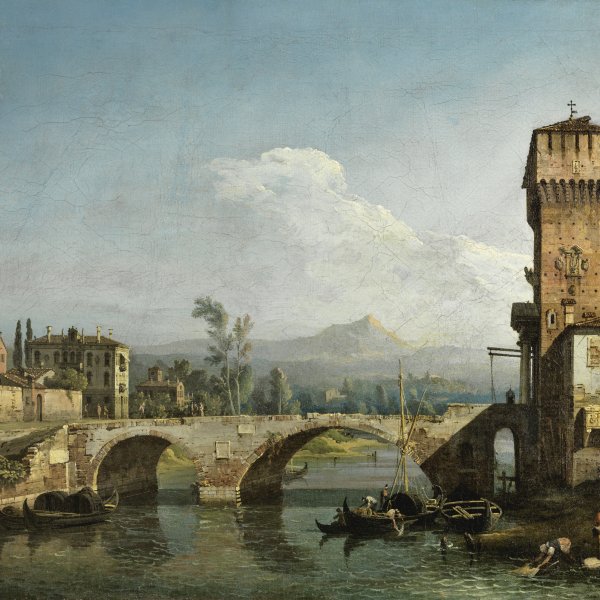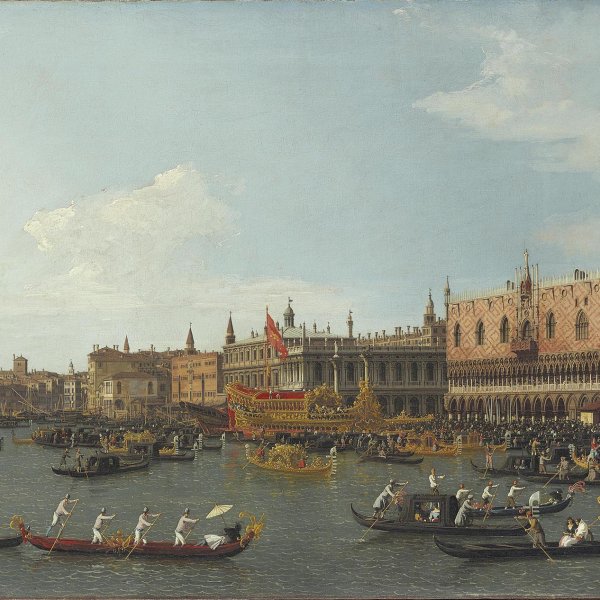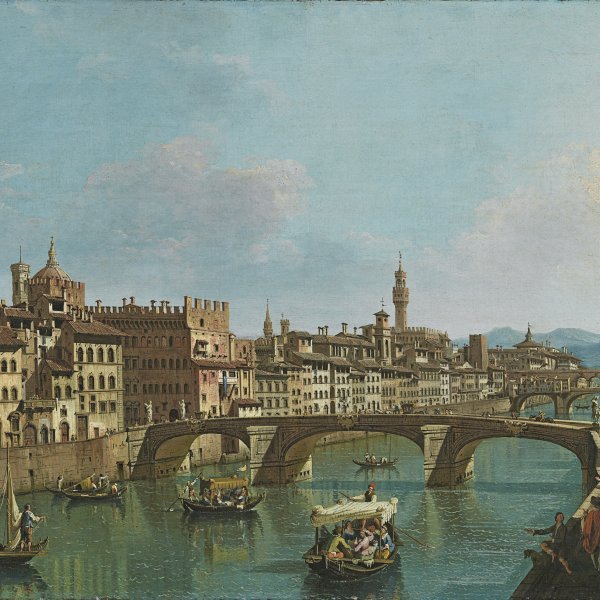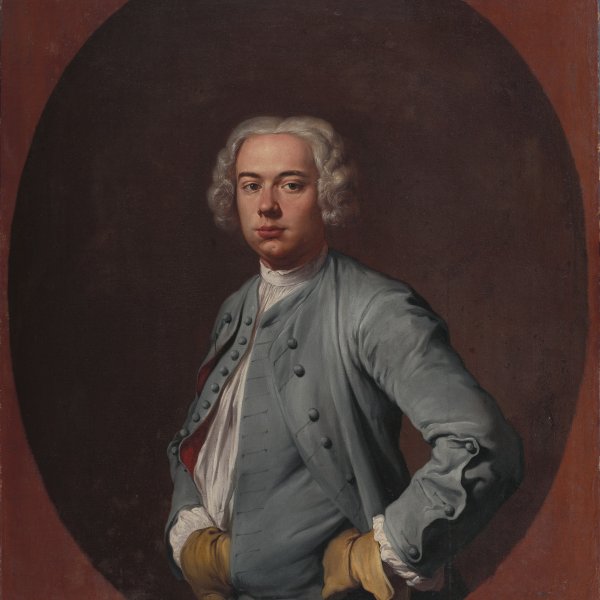Scene in the Garden of a Seraglio
Scene in the Garden of a Seraglio is one of a group of forty-three paintings produced by Guardi between 1741 and 1743. The series depicting scenes of court life in Constantinople was commissioned by Marshal Johannes Matthias von der Schulenburg, for whom Guardi worked for several years. In this canvas, the artist depicts a garden bordered by rather fanciful decorative architecture. The sultan sits at the centre of the composition, smoking a pipe and gazing at a woman dressed in blue. Other court servants are arranged at either side of the core figures, a device intended to focus attention on the central part of the scene.
EA
Inside a garden bordered by light, fanciful, decorative architecture with large Baroque volutes and a bizarre fountain adorned with spurting bronze putti at its centre, the sultan sits on a large pillow. He is dressed in yellow and red and is smoking a long pipe. In front of him stands his favourite of the harem, dressed in blue. A high-ranking Turk is seated on the right, while other servants people the scene.
This unusual painting (with its companion piece, The Favourite of the Harem, in the Thyssen-Bornemisza Collection, Lugano) is also of notable historical significance, since it was part of a series of forty-three "Quadri Turchi", or scenes of court life in Constantinople, painted by Antonio Guardi for Marshal Johannes Matthias von der Schulenburg (1661-1747) between 1741 and 1743. They were brought to Germany after the death of their patron in 1747. Antonio Guardi entered the service of the marshal between 1729 and 1730, after an initial period spent with Count Giovannelli. Schulenburg does not appear to have been especially competent in artistic matters, nor was he prompt in his payments; records show what a lowly social status the artist had; his wages were less than that of a cook or even a manservant, since he was really only paid as a copyist. Schulenburg's "Turkish passion" had its roots in his experience as commander of the troops of the Serenissima fighting the Turkish invasion and in his victories over the enemy years before (he even commissioned portraits of his adversaries in the battles of Venice and Corfu-Ali Bassa and Janum Chogia).
Comprehensive documentation (cash books, reports, inventories, estimates, lists of shipments, etc.) on Schulenburg as a collector and a patron of Antonio Guardi were tracked down by Morassi (1960) in the family archive of a descendant, Count Johann Heinrich von der Schulenburg, in Hehlen. Art historians have made much of the fact that the patron of the episodes of Turkish life must have been familiar (perhaps because he owned them) with the prints derived from the paintings of the Flemish painter Jean Baptiste van Mour (1671-1737), who worked in Constantinople from 1699 and became "peintre ordinaire du Roi du Levant" in 1725. Van Mour (or Vanmour) also published engravings of Turkish customs and Turkish harem life, and it should be remembered that in 1712 Le Hay in Paris published a collection of engravings by Mehlinck based on van Mour (Recueil de cent estampes représentant differents nations du Levant).
With regard to Guardi: payments (two and a half zecchini each) recorded in the cash book-for eleven paintings in 1742 and for another twenty-four in 1743 -account for thirty-five of the forty-three paintings. The remaining eight could have been painted in 1741, the only year for which the account records are missing.
The Thyssen canvas, along with its companion piece, was first published by Heinemann in 1958, and ascribed to Antonio's younger brother Francesco. This attribution was upheld by Watson (1960) and Ragghianti (1963), until Pignatti (1964) corrected it and attributed them to Antonio. Pignatti had noticed that on the back of the preparatory drawing for the companion piece, The Favourite of the Harem, there is a sketch of the figure of the Archangel Raphael for the organ parapet in the church of the same name in Venice, which is definitely by the older Guardi. Since that discovery there has been no doubt that these two works should be given to Giovanni Antonio, although it seems likely that Francesco collaborated on the seventeen Turkish scenes which have come to light so far. Morassi himself (1973) only attributes to Antonio the two Thyssen paintings, the two in the Cini Collection in Venice, and two others in private collections in Bergamo (The Swing, Odalisque, and Soldiers in the Woods), and is of the opinion that the rest were by his brother Francesco. Although the discontinuity of styles is undeniable, it should not be forgotten that Schulenburg demanded rapid execution (eight Turkish paintings were paid for at the same time on 10 May 1743) and that the only name in the documents is Antonio Guardi (either Antonio, "Pittor Guardi", or Guardi).
Roberto Contini










